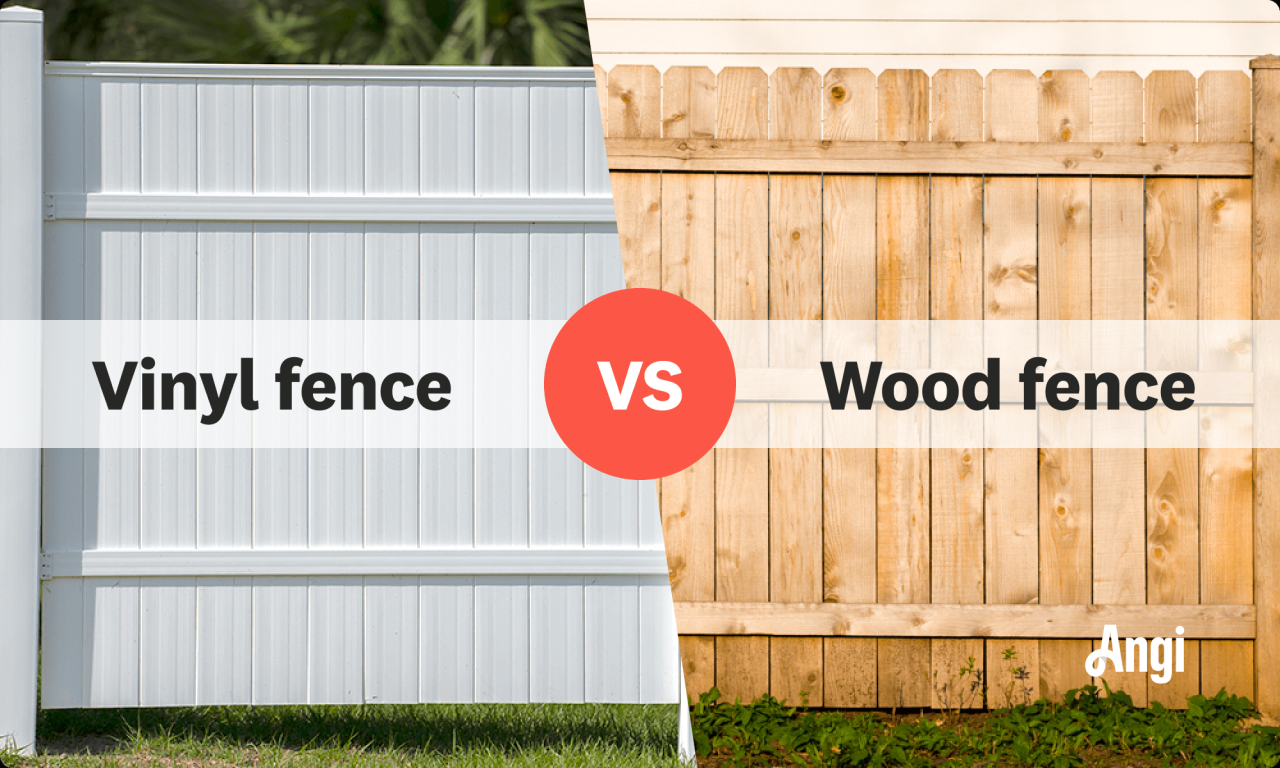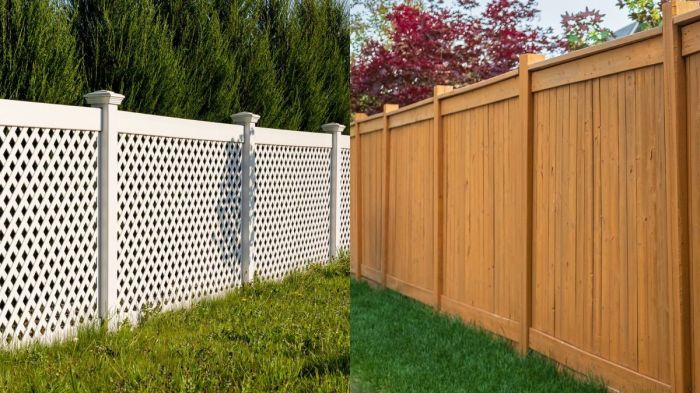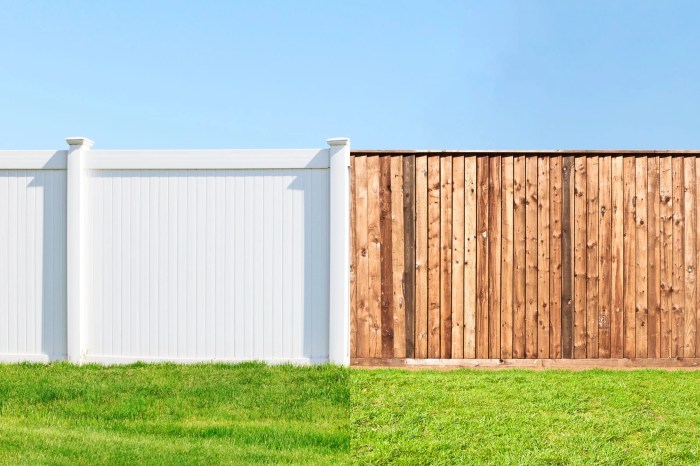Vinyl Fencing vs Wood Fencing: A Comprehensive Comparison

As vinyl fencing vs wood fencing takes center stage, this opening passage beckons readers with a detailed exploration of the key differences between these two popular fencing options. With a focus on durability, aesthetics, and cost considerations, this comparison aims to provide valuable insights for those looking to make an informed decision for their property.
Delving into the characteristics, maintenance requirements, and environmental impact of both vinyl and wood fencing, this discussion sheds light on important aspects to consider before investing in a new fence.
Vinyl Fencing
Vinyl fencing is a popular choice for homeowners looking for a low-maintenance and durable fencing option. Made from PVC (polyvinyl chloride), vinyl fencing offers a variety of benefits compared to traditional wood fencing.
Characteristics of Vinyl Fencing
- Vinyl fencing is resistant to rot, decay, and insect damage, making it a long-lasting option for outdoor use.
- It does not require painting or staining, as the color is integrated into the material during manufacturing.
- Vinyl fencing is available in a wide range of styles, from traditional picket fences to privacy fences, allowing homeowners to choose the design that best suits their needs.
- It is easy to clean with just soap and water, helping to maintain its appearance over time.
Durability of Vinyl Fencing vs. Wood Fencing
- Vinyl fencing is generally more durable than wood fencing, as it does not warp, crack, or splinter like wood can over time.
- Wood fencing may require more frequent maintenance, such as painting, staining, or repairs, compared to vinyl fencing.
- Vinyl fencing is also more resistant to harsh weather conditions, such as rain, snow, and UV rays, which can cause damage to wood fencing.
Styles and Colors of Vinyl Fencing
- Popular styles of vinyl fencing include privacy fences, picket fences, ranch rail fences, and decorative fences.
- Colors range from traditional white and tan to more modern options like gray, brown, and black, allowing homeowners to customize their fencing to match their home's aesthetic.
- Some vinyl fencing manufacturers offer wood-grain textures and finishes to mimic the look of natural wood without the maintenance requirements.
Maintenance Requirements of Vinyl Fencing
- Regular cleaning with soap and water is typically all that is needed to keep vinyl fencing looking its best.
- Inspecting for any damage, such as cracks or loose panels, and repairing them promptly can help prolong the life of the fence.
- Avoiding harsh chemicals or abrasive cleaners when cleaning vinyl fencing can help maintain its color and finish over time.
Wood Fencing

Wood fencing is a popular choice for homeowners looking to add a touch of natural beauty and warmth to their property. Here are some key features and benefits of wood fencing:Wood fencing has a traditional and classic appeal that can enhance the overall look of any property.
The natural grain and color variations of wood give it a timeless and rustic charm that many homeowners find appealing.One of the main advantages of wood fencing is its versatility in terms of customization. Wood can be easily cut, shaped, and stained to achieve different aesthetics and styles.
Whether you prefer a simple and traditional picket fence or a more elaborate design, wood fencing can be tailored to suit your preferences.In terms of environmental impact, wood fencing has both pros and cons. On the positive side, wood is a renewable resource that can be sustainably harvested.
However, the production and treatment of wood fencing materials can have environmental consequences if not done responsibly. It's important to choose sustainably sourced wood and eco-friendly treatment options to minimize the environmental impact of wood fencing.
Customization Options
Wood fencing offers a wide range of customization options to suit different aesthetics and preferences. Here are some common ways wood fencing can be customized:
- Staining or painting: Wood can be stained or painted in a variety of colors to match your home's exterior or create a unique look.
- Fence style: From classic picket fences to privacy fences, wood fencing comes in a variety of styles to suit your needs.
- Decorative accents: Add decorative elements like lattice tops, post caps, or scalloped edges to enhance the visual appeal of your wood fence.
Cost Considerations
When it comes to choosing between vinyl fencing and wood fencing, cost is a crucial factor that needs to be carefully considered. Let's delve into the cost considerations of both options.
Initial Cost Comparison
- Vinyl fencing typically has a higher upfront cost compared to wood fencing. The materials used in vinyl fencing are more expensive, resulting in a higher initial investment.
- Wood fencing, on the other hand, is generally more affordable in terms of upfront costs. The materials used, such as cedar or pine, are readily available and cost-effective.
Long-Term Cost Implications
- While vinyl fencing may have a higher initial cost, it requires minimal maintenance over the years. This can result in cost savings in the long run, as you won't need to spend as much on repairs or replacements.
- Wood fencing, however, requires more maintenance, such as staining, painting, and repairs. These ongoing maintenance costs can add up over time, making wood fencing potentially more expensive in the long term.
Cost-Effectiveness in Durability
Vinyl fencing is known for its durability and longevity, which can make it a cost-effective option in the long run. With minimal maintenance requirements, vinyl fencing can last for decades without deteriorating.
Wood fencing, while initially cheaper, may require more frequent repairs and replacements due to weathering, rot, and insect damage. This can make wood fencing less cost-effective in the long term.
Factors Influencing Overall Cost
- Location: The climate and environmental conditions in your area can impact the maintenance needs of both vinyl and wood fencing, affecting overall costs.
- Installation: The complexity of installation, labor costs, and additional features like gates can influence the overall cost of both types of fencing.
- Quality of Materials: The quality of materials used for vinyl or wood fencing can vary, with higher quality materials often leading to higher costs but better durability.
Installation and Maintenance

When it comes to installing and maintaining fencing, there are significant differences between vinyl and wood options. Let's explore the process and requirements for each type to help you make an informed decision.
Installation Process for Vinyl Fencing
Installing vinyl fencing typically involves the following steps:
- Marking the layout of the fence
- Digging post holes
- Setting the posts in concrete
- Attaching the rails and panels
- Securing the fence with post caps and gate installation
Detailing the Steps for Installing a Wood Fence
The installation process for a wood fence includes:
- Marking the fence line
- Digging post holes
- Securing posts with concrete
- Attaching rails and pickets
- Adding post caps and staining/painting the fence
Comparison of Maintenance Requirements
- Vinyl Fencing:Requires minimal maintenance, typically only needing occasional cleaning with soap and water to remove dirt or mildew.
- Wood Fencing:Needs regular maintenance such as staining or painting every few years to protect against weathering, rot, and pests.
Ease of DIY Maintenance
- Vinyl Fencing:Easy to maintain for DIY enthusiasts due to its low maintenance requirements and simple cleaning process.
- Wood Fencing:DIY maintenance for wood fencing can be more labor-intensive, requiring staining, painting, and repairs to maintain its appearance and structural integrity.
Final Summary

In conclusion, the debate between vinyl fencing and wood fencing offers a nuanced look at the pros and cons of each option. Whether prioritizing longevity, customization, or cost-effectiveness, understanding the intricacies of these materials is key to selecting the perfect fence for your needs.
Quick FAQs
Is vinyl fencing more durable than wood fencing?
Yes, vinyl fencing is generally more durable than wood fencing as it is resistant to rot, decay, and pests.
Are there any environmental concerns with using wood fencing?
Wood fencing can raise environmental concerns due to deforestation and chemical treatments used to preserve the wood.
Which type of fencing is easier to maintain?
Vinyl fencing typically requires less maintenance than wood fencing, as it does not need to be stained or painted regularly.




